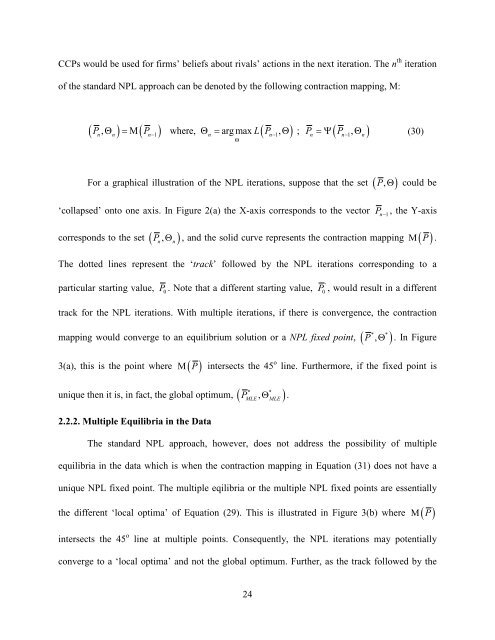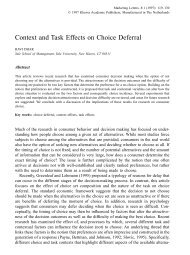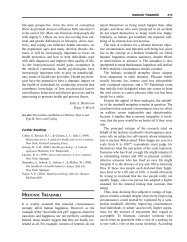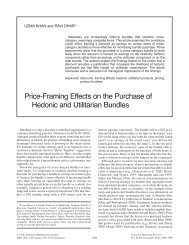The Agglomeration-Differentiation Tradeoff in ... - Yale University
The Agglomeration-Differentiation Tradeoff in ... - Yale University
The Agglomeration-Differentiation Tradeoff in ... - Yale University
Create successful ePaper yourself
Turn your PDF publications into a flip-book with our unique Google optimized e-Paper software.
CCPs would be used for firms’ beliefs about rivals’ actions <strong>in</strong> the next iteration. <strong>The</strong> n th iteration<br />
of the standard NPL approach can be denoted by the follow<strong>in</strong>g contraction mapp<strong>in</strong>g, M:<br />
( Pn, n) ( Pn−1) where, n arg max L( Pn−1, ) ; Pn ( Pn−1,<br />
n)<br />
Θ =Μ Θ = Θ =Ψ Θ (30)<br />
Θ<br />
For a graphical illustration of the NPL iterations, suppose that the set ( P, Θ ) could be<br />
‘collapsed’ onto one axis. In Figure 2(a) the X-axis corresponds to the vector Pn − 1,<br />
the Y-axis<br />
corresponds to the set ( Pn, Θ n)<br />
, and the solid curve represents the contraction mapp<strong>in</strong>g ( P)<br />
24<br />
Μ .<br />
<strong>The</strong> dotted l<strong>in</strong>es represent the ‘track’ followed by the NPL iterations correspond<strong>in</strong>g to a<br />
particular start<strong>in</strong>g value, P 0 . Note that a different start<strong>in</strong>g value,<br />
'<br />
P 0 , would result <strong>in</strong> a different<br />
track for the NPL iterations. With multiple iterations, if there is convergence, the contraction<br />
* *<br />
mapp<strong>in</strong>g would converge to an equilibrium solution or a NPL fixed po<strong>in</strong>t, ( , )<br />
P Θ . In Figure<br />
3(a), this is the po<strong>in</strong>t where Μ ( P)<br />
<strong>in</strong>tersects the 45 o l<strong>in</strong>e. Furthermore, if the fixed po<strong>in</strong>t is<br />
* *<br />
unique then it is, <strong>in</strong> fact, the global optimum, ( MLE , MLE )<br />
2.2.2. Multiple Equilibria <strong>in</strong> the Data<br />
P Θ .<br />
<strong>The</strong> standard NPL approach, however, does not address the possibility of multiple<br />
equilibria <strong>in</strong> the data which is when the contraction mapp<strong>in</strong>g <strong>in</strong> Equation (31) does not have a<br />
unique NPL fixed po<strong>in</strong>t. <strong>The</strong> multiple eqilibria or the multiple NPL fixed po<strong>in</strong>ts are essentially<br />
the different ‘local optima’ of Equation (29). This is illustrated <strong>in</strong> Figure 3(b) where Μ ( P)<br />
<strong>in</strong>tersects the 45 o l<strong>in</strong>e at multiple po<strong>in</strong>ts. Consequently, the NPL iterations may potentially<br />
converge to a ‘local optima’ and not the global optimum. Further, as the track followed by the







